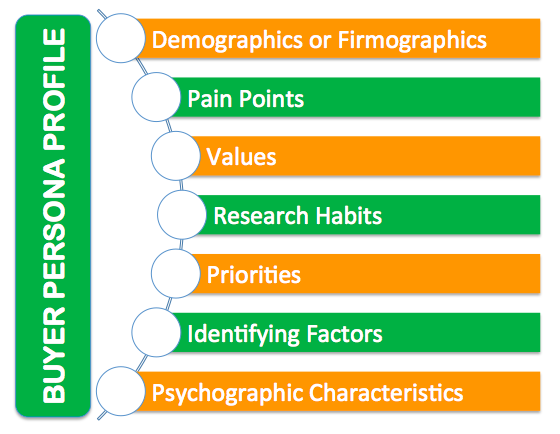How to Build an Epic Buyer Persona Profile

No one needs more irrelevant marketing messages in their life. To stand out amidst the noise in an era where 91% of marketers are creating custom content, it’s critical to invest in relevant information. In fact, a recent eMarketer study cited targeting content as a top priority for 47% of savvy companies.
While your inbound strategy should revolve around creating content people love, it’s even more important to generate marketing that the right people love. Articles created to satisfy a broad segment of website visitors won’t capture the hearts of anyone.
Developing a deep knowledge of your ideal customer, a concept known in the marketing realm as buyer persona profiling, is critical to increasing the relevance of your efforts.
What the Heck is a Buyer Persona?
A buyer persona is a vibrant profile of your company’s ideal customer. This should capture the type of person with an incredible need for your product and a love for your company; who will remain a loyal client for years, and tell all of their friends about how remarkable you are.
More technically, they’re “an example of the real person you need to influence, crafted from specialized interviews you conduct with actual buyers,” in the words of Adele Revella, a leading expert on the topic. When correctly prepared and applied, a buyer persona can help you identify the forms of messaging which will convert the right website visitors into leads, and leads into customers.
Great marketers rely on demographics and consumer insights to target their marketing. Major companies may leverage focus groups to determine consumer reactions to their marketing messages, and spend significant time and budget compiling demographic insights. A buyer persona profile is the great equalizer, because it allows companies of all sizes to improve their targeting. The following elements should make an appearance in your persona profile:

1. Demographics or Firmographics
What are the basic facts about your ideal customer, including age, gender, and geographic location? If you’re a B2B company, how big are the companies you’re trying to acquire? What industries are they in? As HubSpot’s Corey Eridon points out, demographics are the perfect starting point for profiling, because they’re relatively easy to obtain from your existing marketing database or customer relationship management software (CRM).
2. Pain Points
Why does your buyer persona need your solution in the first place? A pain point is exactly what it sounds like: a problem or need that’s so unpleasant, an individual has to begin searching for branded products or services and spend money in order to solve it. Whether customers are driven to your company by a major life event or a need to prove a point to their peers, you should know how your company is used to solve problems.
3. Priorities
Do your customers tend to be budget shoppers, or do they worry deeply about impressing their social circle? Do you tend to sell to executive assistants with a need to please a particularly choosy boss? Ordering priorities can allow you to create marketing materials that cut to the chase: if budget isn’t an issue, you can focus on value or other things that matter most.
4. Values
Are your ideal customers environmentally-conscious activists? Do they aspire to grow their company quickly? It’s critical to address values separately from priorities, because they affect how your company should define the bigger picture. Being able to clearly define how your company will help your consumers achieve their dreams, whether that’s saving money on their monthly grocery budget or performing their job more efficiently, should guide your company’s entire online presentation.
5. Research Habits
Are your customers engaged with the web every waking moment, or are they just starting to warm up to the idea of social media and search engines? The best way to determine research habits is through quantitative website metrics, specifically referral traffic sources and the keywords driving the highest volume of search to your website. Ideally, this research should be performed with the help of closed-loop analytics, which track how website visitors who become customers find your website, and the pages they engage with during their prospect stage.
6. Identifying Factors
What makes your buyer persona different from any other 27 year-old female event planner who aspires to own her own business? It’s probably difficult to tell why some customers who fit your demographics profiles purchase, and other’s don’t, but one of the best ways to determine this factor is likely through interviews with your sales team. Inquire about the factors they used to distinguish hot leads, which could include anything from the questions asked during the research stage to a company’s organizational chart.
7. Psychographic Characteristics
Would your ideal customers rather spend their weekend camping, or exploring urban coffee shops? Do they identify primarily as an early-adopter, or are they apathetic toward technology? Simply defined, psychographic characteristics are the collision of psychology and advertising, formally “attitudes, opinions, and personality traits.” They’re inherently abstract, as AdZerk points out, but that doesn’t mean they’re optional. By developing an understanding of how your product fits into the larger identity of your buyer persona, your content marketing can become significantly more vibrant.
How to Create a Buyer Persona Profile
For established companies, making the move to schedule interviews with your existing customer base should be the first step towards creating a buyer persona. Startups and companies in the earliest planning phases don’t get a free pass from interviewing, though – Ellie Mirman of HubSpot recommends using Craigslist or a similar service to find appropriate members of the public to interview.
Extend the invitation to chat to both your best and worst customers, in order to gain a more comprehensive understanding of the factors that make your buyer persona different. Engaging with customers who’ve had a negative or mediocre experience with your product or service can salvage damaged relationships, but it can also help you gain a better understanding of how your product is perceived from the outside.
Dissatisfied customers may feel that your product was harder-to-use than your content marketing let on, that you’re not using sufficiently sustainable packaging, or any other number of factors that can change your direction. Interviewing customers of all satisfaction levels will help you pinpoint your buyer persona more effectively.
Offer clear incentive for customers to participate in your research, which can range from a discount to a small, useful gift. Explain the estimated length of the session, define the fact you’re trying to gain better insight of your customers, and assure your interview participants that you won’t be releasing their personal information.
Try your best to keep the session to 20 minutes or less, and choose the most relevant options from the sample questions below:
- How do you research products and services? Do you trust online reviews?
- Do you use social media? What is your favorite network?
- How much time do you spend online? Do you use smartphones and tablets?
- What is your job title and career goals?
- What skills, knowledge, and tools are required to succeed at your job?
- What are the biggest challenges you face in life or work?
- What blogs, news sources, or media do you consume on a regular basis?
- What is your educational background?
- What are some of your favorite brands and products?
- Do you prefer to communicate via email, phone, or in-person?
- Do you like learning through videos and webinars, or eBooks better?
- How do you search for information online?
- What are your long-term goals?
While this list is just a sampling of the questions you could choose to ask in order to build a buyer persona, it’s critical to focus on acquiring the insights that are difficult to track through web analytics. It’s important to use your time with customers to gain a bigger picture of attitudes, values, and habits.
Use these insights, in conjunction with metrics and contributions from your sales and customer service team, to develop a document which details every aspect of how your ideal customer will find and select your company.
Mistakes to Avoid While Creating Buyer Personas
When correctly leveraged, a buyer persona profile has the power to transform your content marketing strategy and business. However, it’s not easy to compile an accurate profile which combines reality with your sales and marketing goals. As Revella points out, the absolute worst mistake you can make is failing to bring conversations with your customers into the equation. While your sales and customer service staff certainly have extensive knowledge about your buyer persona, interviews will bring in a totally accurate perspective.
The following mistakes can result in an inaccurate and unhelpful final product:
1. Asking the Wrong Questions
If you take full advantage of your customer’s time, the insights you glean will be gold. You’ll learn more about the people you’re trying to acquire than your competitors know, and gain the power to create marketing that win’s the right people’s hearts and minds. However, unless your ideal customer is an incredibly sophisticated marketer, avoid asking questions that will just be confusing. It’s additionally critical to avoid offending anyone.
The worst types of interview questions could include:
- How many pages do you typically visit on a website before becoming a lead?
- When did your [pain point] get bad enough you had to buy our product?
- What did you think of our landing page form?
Avoid jargon, technical questions, or anything that can be construed as overly personal. Your interviews should make your customers feel like you value their business and insights, not consider them research subjects.
2. Developing Too Many Buyer Personas

Many major companies and savvy small businesses have more than one buyer persona. However, if you’re just beginning to practice profiling, trying to target 15 different types of customers can be overwhelming. Focus on capturing your ideal customer, getting the interview process down, and applying the results to your sales and marketing strategy before you move on.
3. Filling in the Blanks
Next to simply skipping the interview stage, the worst thing you can do is to make leaps of judgment while profiling. Never assume that customers are attracted to your company because you’re focused on community service, or that your technical white papers are the star of your content marketing strategy.
Decisions made without customer insights aren’t always sound, and a buyer persona based on personal opinion simply won’t advance your marketing game.
Fantastic marketing is customer-centric, ready-to-scale and relevant. Buyer persona profiles can be something of a silver bullet for companies of all sizes and in virtually any industry, because the insights allow you to gain a sufficiently deep understanding of your customers to answer their questions and address their needs from the moment they find your website.
Curious about free tools and templates to help you get started? Check out our blog article Resources for Creating Buyer Personas Using the Right Content, which includes links to 11 of the best articles, interviews and tip sheets available on the web.
Does your company have a buyer persona? How did you acquire the customer insights to build the profile?

Comments (0)